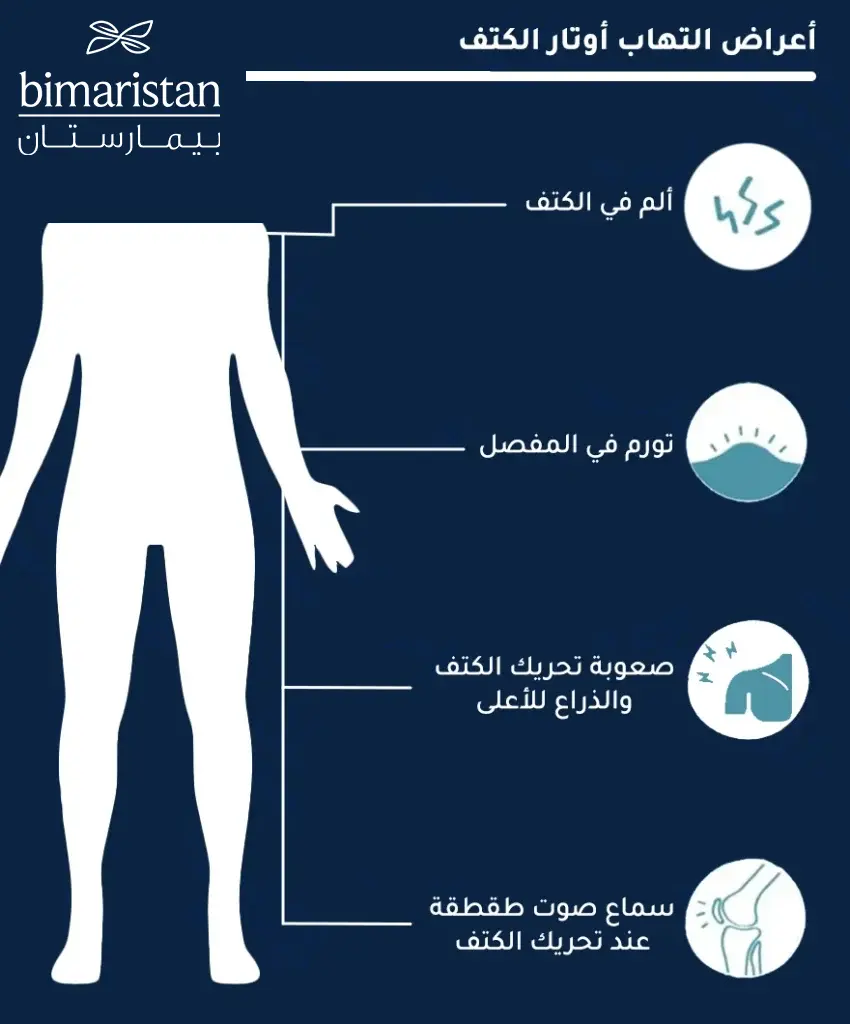عندما تصاب بالتهاب أوتار الكتف سوف تشعر بألم مع صعوبة في تحريك الذراع والكتف، عادة ما يحدث التهاب الأوتار نتيجة نشاطات مجهدة تضع حمل شديد على اوتار مفصل الكتف.
حدوث التهاب في وتر من أوتار الكتف ليس بالأمر النادر فكثيراً ما يعاني الرياضيون من التهابات اوتار الكتف Shoulder Tendinitis لكنها لا تقتصر فقط على الرياضيين إذ يمكن أن يتعرض أي شخص لإصابة مفاجئة تسبب له التهاب في أحد أوتار الكتف.
تكمن وظيفة الوتر بربط العضلات مع العظام وذلك من أجل تأمين حركة متناسقة وحماية المفصل من التعرض للإصابات إلا أن الأوتار معرضة لخطر الالتهاب، تابع معنا لتتعرف على كيفية حدوث التهاب أوتار الكتف وأعراضه وكم يستغرق حتى يشفى.
لمحة عن التهاب أوتار الكتف
يتكون مفصل الكتف عند الإنسان من مجموعة عضلات وأوتار تعمل على تثبيت المفصل وضمان استقراره أثناء الحركة وذلك من خلال الربط المحكم بين الكتف والذراع العلوية.
يوجد بشكل رئيسي مجموعتين من الأوتار بالكتف وهما وتر عضلة الذراع الأمامية والتي تعرف باسم العضلة ذات الرأسين بالإضافة إلى أوتار العضلات في الكتف المعروفة بعضلات الكفة المدورة، قد يصيب الالتهاب أي وتر من هذه الأوتار.
يعتبر التهاب أوتار الكتف من أشيع الالتهابات التي تصيب الاوتار في الجسم ويعود السبب في ذلك لكون المفصل مسؤول عن طيف واسع من الحركات فهو يشارك في أغلب حركات الطرف العلوي.
قد يؤدي الالتهاب في حال عدم علاجه جيداً إلى حدوث تمزق بالوتر والذي يستدعي الحاجة لإجراء عمل جراحي لإصلاحه، لذا يفضل استشارة الأخصائي باكراً فور ملاحظة أعراض التهاب اوتار الكتف.

أعراض التهاب أوتار الكتف
تميل الأعراض لتزداد سوءاً مع مرور الوقت فقد يلاحظ المصاب في البداية بأن أعراضه تظهر بالحركة وتخف مع الراحة لكن مع تطور الإصابة تصبح الاعراض ظاهرة حتى في أوقات الراحة، قد تختلف علامات وأعراض التهاب الأوتار من شخص لآخر ولكن غالبًا ما تظهر إحدى هذه الاعراض وهي:
- ألم يزداد شدة عند تحريك الكتف والذراع
- تيبس وصلابة في مفصل الكتف
- تورم خفيف بالمفصل
- سماع صوت طقطقة في الكتف عند تحريكه
- صعوبة في إبقاء الذراع مرفوعة للأعلى
غالباً ما يكون العرض الأول الذي يدفع المريض لمراجعة طبيب المفاصل هو الألم المشتد عند رفع الكتف أو الذراع.

أسباب التهاب أوتار الكتف
التهاب وتر الكتف هو حالة من فرط التحميل على الوتر تؤدي بمرور الوقت لالتهابه، وقد تحصل في حالات أخرى إصابات شديدة تؤثر على أحد الأوتار محدثة تمزق أو التهاب مفاجئ بالوتر.
يحدث فرط الحمل بسبب الاستخدام المفرط للكتف وأوتاره خاصةً عند ممارسة هوايات تتطلب ذلك كالتنس والغولف وغيرها من الممارسات الأخرى وليس بالضرورة أن تكون رياضي حتى تصاب بالالتهاب فقد يحدث أيضاً عند الأشخاص ذوي المهن التي تحتاج لرفع أوزان ثقيلة وإبقاء الأكتاف مرفوعة للأعلى كما أن تعرضك لإصابة مُبرحة كالسقوط على كتفك قد يتسبب في حدوث التهاب في أوتار الكتف.
تشخيص التهاب أوتار الكتف
سيسألك الأخصائي عن أعراضك بالتفصيل ومن ثم سيقوم بإجراء فحص جسدي عبر عمل بعض الحركات كرفع الذراعين لأعلى الرأس والتي عادةً ما تحرض الم المفصل عند مرضى التهاب الأوتار.
غالباً ما يتمكن طبيب المفاصل من وضع التشخيص استناداً على الفحص الجسدي فقط إلا أنه قد يجري اختبارات أخرى لنفي وجود اسباب تتسبب بظهور علامات مشابهة لالتهاب أوتار الكتف ومن هذه الاختبارات ما يلي:
صورة الأشعة السينية X-ray
يظهر بواسطة هذه الصورة البنى والأنسجة الداخلية كالعظام حيث يتم البحث والتحري عن أية مشاكل أو شذوذات مثل وجود كسور عظمية أو غيرها من الحالات والأسباب الأخرى المسببة للأعراض.
الرنين المغناطيسي MRI
تفيد هذه التقنية بالحصول على رؤية أوضح للأنسجة الباطنة بالجسم وذلك من خلال أمواج مغناطيسية تخترق الأنسجة والأعضاء لتعطي صور واضحة يتم عرضها على شاشة الحاسوب.
كيفية علاج التهاب أوتار الكتف
يهدف العلاج بِشكل رئيسي لتخفيف الألم وتقليل شدة الالتهاب مع تحسين مجال وحركة مفصل الكتف عند المريض إضافةً لمنع حدوث مضاعفات لالتهاب الأوتار.
إن كيفية اختيار الطريقة المناسبة لعلاج التهاب الاوتار تعتمد على شدة الالتهاب ودرجة تضرر الوتر إضافةً إلى عمر المريض وحالته الصحية العامة فقد يوصي الطبيب في المراحل الخفيفة من التهاب أوتار الكتف بالراحة مع تجنب تحريك الكتف ورفع الذراع واللجوء لعلاجات منزلية مخففة للألم كتطبيق الثلج والكمادات الدافئة على مكان التألم.
أدوية علاج التهاب أوتار الكتف
يفيد استعمال الأدوية المضادة للالتهاب اللاستيروئيدية NSAIDS في علاج وتخفيف آلام التهاب الأوتار، فمن الأمثلة عن هذه المجموعة دواء الإيبوبروفين والأسبرين مع الانتباه إلى احتمال حدوث بعض التأثيرات الجانبية من أخذ هذه الادوية كحدوث تسمم كلوي أو تشكل قرحات هضمية مثل قرحة الاثنى عشر.
تعد الستيروئيدات القشرية من الادوية التي تفيد أيضاً في علاج التهاب الأوتار وهي تعطى إما فموياً أو عن طريق حقنها مباشرة في مفصل الكتف، تعتبر أحد أفضل مضادات الالتهاب الموجودة إلا أن استعمالها لفترة طويلة قد يسبب ضعف بالأوتار والذي يؤهب لحدوث قطع بالوتر.
علاج التهاب أوتار الكتف عبر حقن البلازما
تم مؤخراً استخدام طريقة جديدة لعلاج أمراض المفاصل وخشونتها عبر الحصول على عينة بلازما بشرية مستخلصة من دم الشخص نفسه الذي سيخضع للعلاج ليتم لاحقاً حقنها داخل المفصل المتضرر، تعد هذه الطريقة من العلاجات الواعدة التي أثبتت فائدتها في علاج مشاكل مختلفة في الركبة والمفاصل عموماً، اقرأ أكثر عن فوائد حقن البلازما للركبة.

تمارين علاج التهاب أوتار الكتف
يفيد العلاج الطبيعي في تقوية العضلات والأوتار في منطقة الكتف وذلك لتسريع شفاء الالتهاب والوقاية من حدوثه مجدداً، يقوم المعالج الفيزيائي بتعليمك بعض التمارين التي تساهم في إطالة وتقوية الأوتار لديك مثل إحداث تقلص بالعضلة وهي مشدودة وذلك لفائدتها في تقوية أوتار كتفك.
عملية التهاب أوتار الكتف
عندما يتعرض أحد اوتار مفصل الكتف لتمزق جزئي ولا تتحسن اعراض المريض بعد تجربة العلاجات السابقة تظهر الحاجة لإجراء عمل جراحي لإصلاح التضرر بالوتر وتخفيف أعراضه.
يمكن إجراء العملية باستخدام منظار الكتف والذي يتميز بكونه إجراء طفيف التوغل وآمن لحدٍ كبير، يقوم الجراح بعمل شقوق جراحية صغيرة يتم من خلالها إدخال أدوات تستخدم لاستئصال الأجزاء الملتهبة من الوتر أو إصلاحه.
منظار الكتف هو الخيار الأفضل لإجراء العملية في معظم الأحيان ولكن في إصابات التهاب الأوتار الشديدة قد ينصح الجراح بإجراء الجراحة التقليدية.
الوقاية من التهاب اوتار الكتف
بما أن السبب الأكثر شيوعاً لحدوث التهاب اوتار الكتف يعزى للتحميل الزائد على المفصل وإجهاده فإنه يمكن تجنب الالتهاب والوقاية منه قدر الإمكان عبر اتباع هذه النصائح:
- تجنب حمل أوزان ثقيلة جدًا فوق مستوى الرأس
- تأكد من أخذ الوضعية المناسبة والصحيحة عند ممارستك للرياضة
- قم بالإحماء جيداً قبل البدء بممارسة الرياضة
- لا تجهد المفصل بِشكل مفاجئ وقم بزيادة نشاطك الرياضي تدريجياً
- تقوية كتفك وتمديده بانتظام عبر إجراء حركات التمدد Stretching exercises
وبالنهاية فإن التهاب أوتار الكتف يعد من الحالات الشائعة حيث يُعتبر أحد أكثر أنواع إلتهابات الأوتار شيوعاً في جسم الإنسان، أول ما يشعر به المريض هو ألم المفصل المشتد بالحركة ما يلبث أن يصبح شديداً لدرجة منع المصاب من تحريك كتفه بحرية، بالنسبة لكيفية علاج هذه الحالة فهي تختلف بحسب درجة الالتهاب وشدته فقد يكتفى بالراحة أو قد يوصى في مراحل متقدمة بإجراء عملية جراحية لإصلاح الأوتار.
المصادر:








